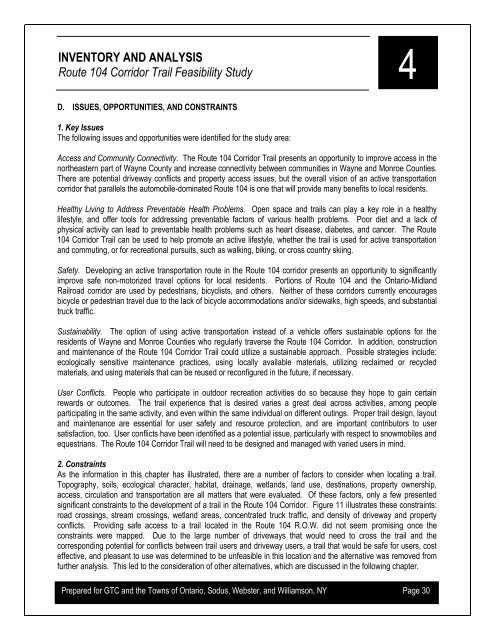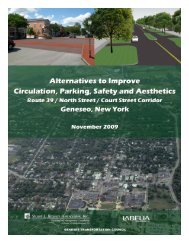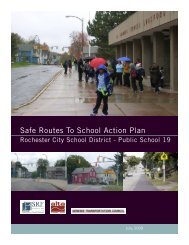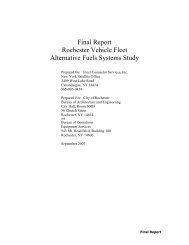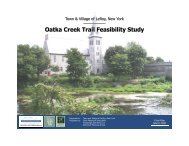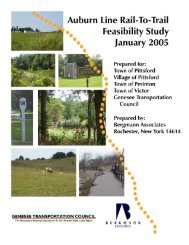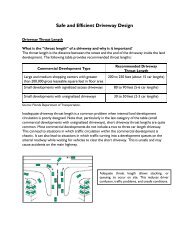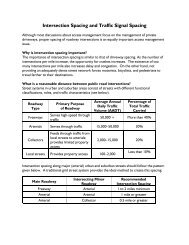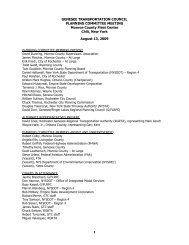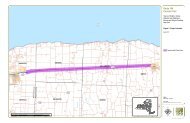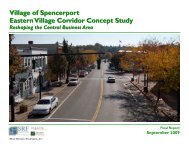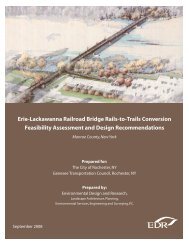Route 104 Corridor Trail Feasibility Study - Genesee Transportation ...
Route 104 Corridor Trail Feasibility Study - Genesee Transportation ...
Route 104 Corridor Trail Feasibility Study - Genesee Transportation ...
You also want an ePaper? Increase the reach of your titles
YUMPU automatically turns print PDFs into web optimized ePapers that Google loves.
INVENTORY AND ANALYSIS<br />
4<br />
<strong>Route</strong> <strong>104</strong> <strong>Corridor</strong> <strong>Trail</strong> <strong>Feasibility</strong> <strong>Study</strong><br />
D. ISSUES, OPPORTUNITIES, AND CONSTRAINTS<br />
1. Key Issues<br />
The following issues and opportunities were identified for the study area:<br />
Access and Community Connectivity. The <strong>Route</strong> <strong>104</strong> <strong>Corridor</strong> <strong>Trail</strong> presents an opportunity to improve access in the<br />
northeastern part of Wayne County and increase connectivity between communities in Wayne and Monroe Counties.<br />
There are potential driveway conflicts and property access issues, but the overall vision of an active transportation<br />
corridor that parallels the automobile-dominated <strong>Route</strong> <strong>104</strong> is one that will provide many benefits to local residents.<br />
Healthy Living to Address Preventable Health Problems. Open space and trails can play a key role in a healthy<br />
lifestyle, and offer tools for addressing preventable factors of various health problems. Poor diet and a lack of<br />
physical activity can lead to preventable health problems such as heart disease, diabetes, and cancer. The <strong>Route</strong><br />
<strong>104</strong> <strong>Corridor</strong> <strong>Trail</strong> can be used to help promote an active lifestyle, whether the trail is used for active transportation<br />
and commuting, or for recreational pursuits, such as walking, biking, or cross country skiing.<br />
Safety. Developing an active transportation route in the <strong>Route</strong> <strong>104</strong> corridor presents an opportunity to significantly<br />
improve safe non-motorized travel options for local residents. Portions of <strong>Route</strong> <strong>104</strong> and the Ontario-Midland<br />
Railroad corridor are used by pedestrians, bicyclists, and others. Neither of these corridors currently encourages<br />
bicycle or pedestrian travel due to the lack of bicycle accommodations and/or sidewalks, high speeds, and substantial<br />
truck traffic.<br />
Sustainability. The option of using active transportation instead of a vehicle offers sustainable options for the<br />
residents of Wayne and Monroe Counties who regularly traverse the <strong>Route</strong> <strong>104</strong> <strong>Corridor</strong>. In addition, construction<br />
and maintenance of the <strong>Route</strong> <strong>104</strong> <strong>Corridor</strong> <strong>Trail</strong> could utilize a sustainable approach. Possible strategies include:<br />
ecologically sensitive maintenance practices, using locally available materials, utilizing reclaimed or recycled<br />
materials, and using materials that can be reused or reconfigured in the future, if necessary.<br />
User Conflicts. People who participate in outdoor recreation activities do so because they hope to gain certain<br />
rewards or outcomes. The trail experience that is desired varies a great deal across activities, among people<br />
participating in the same activity, and even within the same individual on different outings. Proper trail design, layout<br />
and maintenance are essential for user safety and resource protection, and are important contributors to user<br />
satisfaction, too. User conflicts have been identified as a potential issue, particularly with respect to snowmobiles and<br />
equestrians. The <strong>Route</strong> <strong>104</strong> <strong>Corridor</strong> <strong>Trail</strong> will need to be designed and managed with varied users in mind.<br />
2. Constraints<br />
As the information in this chapter has illustrated, there are a number of factors to consider when locating a trail.<br />
Topography, soils, ecological character, habitat, drainage, wetlands, land use, destinations, property ownership,<br />
access, circulation and transportation are all matters that were evaluated. Of these factors, only a few presented<br />
significant constraints to the development of a trail in the <strong>Route</strong> <strong>104</strong> <strong>Corridor</strong>. Figure 11 illustrates these constraints:<br />
road crossings, stream crossings, wetland areas, concentrated truck traffic, and density of driveway and property<br />
conflicts. Providing safe access to a trail located in the <strong>Route</strong> <strong>104</strong> R.O.W. did not seem promising once the<br />
constraints were mapped. Due to the large number of driveways that would need to cross the trail and the<br />
corresponding potential for conflicts between trail users and driveway users, a trail that would be safe for users, cost<br />
effective, and pleasant to use was determined to be unfeasible in this location and the alternative was removed from<br />
further analysis. This led to the consideration of other alternatives, which are discussed in the following chapter.<br />
Prepared for GTC and the Towns of Ontario, Sodus, Webster, and Williamson, NY Page 30


